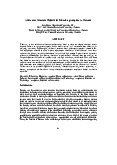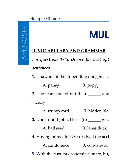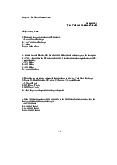

Preview text:
I. LISTENING (50 points) – 27.10.22 H H ƯƠNG D NG D ÂN PH N PH ÂN KI N KI Ê M TRA NGHE HI U Ê Bài nghe g m ồ 04 ph n ầ ; m i ỗ ph n ầ đư c ợ nghe 02 l n ầ , m i ỗ l n
ầ cách nhau 5 giây; m ơ đ u ầ và k t ê thuc m i ỗ ph n ầ nghe co tin hi u ê . Mơ đ u ầ và k t
ê thuc bài nghe co nh c ạ hi u
ê . Thi sinh co 02 phut để hoàn ch n i h bài trư c ớ nh c ạ hi u ê k t ê thuc bài nghe. M i
ọ hướng d n
ẫ cho thi sinh đã co trong bài nghe. Part 1. For ques t ques i t o i n o s n 1- 1 5 - , 5 , lils i t s e t n e to t a tal t k al abou abo t u depr de e pr s e s s i s o i n o n amo am n o g n st s u t de u n de t n s t and dec de i c de i wh w e h t e h t e h r e r th t e h s e e s st s ate t m ate e m n e t n s t are ar Tru r e u (T ( ) T or o Fals al e s (F) ( acc ac o c r o di r n di g n to t wh w at h yo y u o he h ar e . Wr W i r t i e t yo y u o r u answ ans e w r e s r in i th t e h co c r o r r e r s e po s n po di n n di g n nu n m u be m r be e r d e box bo es e pro pr vi v de i d de . 1.
The number of students with anxiety increased by 135% in eight years. 2.
College students experiencing several mental health problems doubled by over 60%. 3.
According to Dr Lipson, traditional college years, a key developmental time, coincides with the age of onset for lifelong mental illnesses. 4.
Most people suffering from their mental health crises will have them after 24. 5.
In the COVID-19 pandemic, lockdowns and school closures have resulted in many students worrying about their uncertain future. You o r u r ans w ans e w r e s r : 1. 1. 2. 2. 3. 3. 4. 4. 5. Part 2. For Fo r quest ques i t o i n o s n s 6- 6 1 - 0 1 , 0 l ils i t s e t n e to t t w t o w st s u t de u n de t n s t tal t k al i k n i g n abou abo t u t th t e h mo m c o k c e x e am x s am th t e h y e y hav h e av j u j s u t s tak t e ak n e n and ans w ans e w r e th t e h e ques t ques i t o i n o s n . s . W ri r t i e t e N O N M O OR M E OR E T H T A H N A N F OUR F OUR W OR W D OR S D S t ak t en e n f r f o r m o m t h t e h e r e r c e or o di r n di g n f g o f r o r e ac e h ac h a ns n w s e w r e . 6.
According to Adam, what are essay papers inappropriate for assessing?
.............................................................................................................................................................. 7. .
For which reason does Mary criticise multiple-choice questions?
.............................................................................................................................................................. 8.
What are two words used by Mary to describe a practice exam with 12 test stations?
.............................................................................................................................................................. 9.
In the problem-solving tests, what do students have to do when working in groups?
..............................................................................................................................................................
10. After the re-sits in September, by which action are any problems dealt with?
.............................................................................................................................................................. Part 3. For Fo r quest ques i t o i n o s n 11 1 - 1 1 - 5 1 , 5 lils i t s e t n e to t an in i t n e t r e v r i v e i w e wi w t i h t so s m o e m o e n o e n wh w o h co c n o s n u s l u t l e t d e a ‘lilf i e f co c ac o h ac ’ h to t im i pr m o pr v o e v he h r e lilf i e f and ch c o h o o s o e s e th t e h c o c r o r r e r c e t c ans w ans e w r e A , A B, B , C or o r D w h w i h c i h c f i f t i s t bes be t s t acc ac o c r o di r n di g n to t o wh w at h y o y u o u he h ar e . W r W i r t i e t y o y u o r u r answ ans e w r e s r i n i t h t e h co c r o r r e r s e po s n po di n n di g n g n u n m u b m e b r e e r d bo d x bo es e s pr o pr v o i v de i d. de
11. Brigid says that she consulted a life coach because ______.
A. she had read a great deal about them
B. both her work and home life were getting worse
C. other efforts to improve her life had failed
D. the changes she wanted to make were only small ones
12. What did Brigid’s coach tell her about money?
A. It would be very easy for Brigid to get a lot of it.
B. Brigid’s attitude towards it was uncharacteristic of her.
C. Brigid placed too much emphasis on it in her life.
D. Few people have the right attitude towards it.
13. What does Brigid say about her reaction to her coach’s advice on money?
A. She felt silly repeating the words her coach gave her.
B. She tried to hide the fact that she found it ridiculous.
C. She felt a lot better as a result of following it.
D. She found it difficult to understand at first.
14. What does Brigid say happened during the other sessions?
A. She was told that most people’s problems had the same cause.
B. Her powers of concentration improved.
C. Some things she was told to do proved harder than others.
D. She began to wonder why her problems had arisen in the first place. 15. What has Brigid concluded?
A. The benefits of coaching do not compensate for the effort required.
B. She was too unselfish before she had coaching.
C. She came to expect too much of her coach.
D. It is best to limit the number of coaching sessions you have. You o r u r ans w ans e w r e s r : s 11. 11. 12. 12. 13. 13. 14. 14. 15. Part 4. For Fo quest ques i t o i n o s n 16 1 - 6 2 - 5 2 , 5 lils i t s e t n e to t Nei e li and Sam S dis di c s u c s u s s i s n i g n ho h w o cl c e l v e e v r e art ar i t f i i f c i i c al i in i t n e t l e llilge i n ge c n e c (A ( I A ) I is i . s Wr W i r t i e t NO N MOR M E OR TH T A H N A TH T R H E R E E WOR W D OR S D tak t e ak n e fr f o r m o th t e h re r c e o c r o di r n di g n fo f r o eac e h ac blank. ank Wr W i r t i e t yo y u o r u answ ans e w r e s r in i th t e h co c r o r r e r s e po s n po di n n di g n nu n m u be m r be e r d e bo d x bo es e s pr o pr v o ide i d. de
In real life, although AI using artificial brain cells to
(16) ______ real brain cell activity is making huge
progress in entirely different fields, it is a long way behind human levels of intelligence. “Frosted oysters”, a (17)
______ made by AI is a typical example. You Look Like a Thing and I Love You, a book written by Janelle Shane
about her amusing experiences and
(18) ______ with AI, is another example. The book title is produced by AI –
“machine learning” – when asked to write ______ for strangers to (19)
start up a romantic conversation with other
attractive ones. To find out the way to solve a problem without human programmers writing down (20) (20) ______ instructions and
(21) ______ from the start, AI uses a process of (22)
(22) ______ which sometimes comes up with
more wrong answers. Even by repeating the same activity many times, learning from seeing how it goes wrong, and ______ the (23)
number of incorrect answers, AI can not always discover the best result. Instead, success can be achieved purely by a (24)
(24) ______. So, in terms of (25)
(25) ______, AI is currently just as clever as an earthworm.
There still need to be humans involved at the beginning of problem-solving procedures. You o r u r ans w ans e w r e s r : s 16. 21. 17. . 22. 18. 23. 19. 24. 20. 25.




